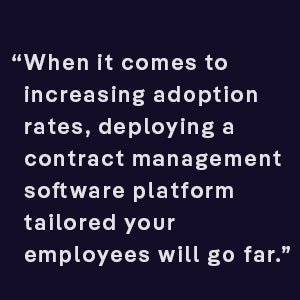Running the legal department in a growing business is challenging enough these days without having to create effective business practices from scratch. After all, you likely do not have the time to conduct in-depth research, work with a team of analysts, or meet with your peers, to develop a comprehensive set of strategies to better manage your business-critical documents.
Perhaps, though, you have already discovered our comprehensive Contract Management Primer. This resource furthers legal professionals’ understanding of creating, negotiating, closing, controlling, and analyzing their companies’ most valuable documents. The files that hold their organization, along with its employees, customers, suppliers, and partners, to account.
On top of this, we came up with a contract management guide of best practices, following scores of customer engagements over the years. Here are six of them.
1. Audit Your Existing Processes
Re-engineering your current business processes takes more than investing in legal technology. Following our contract management guide, you should first perform an internal fit-gap analysis of your existing practice. This will identify the “analog” contract management practices that should be carried over into the digital world. It is also important to find the bottlenecks, redundancies, or outright mistakes that need to be replaced with proven, effective contract management processes working for your industry peers and competitors.
However, self-audits can be adversely affected by blind spots, due to personal relationships, biases, and the human inability to ‘see the forest for the trees.’ Conversely, an audit by a neutral, third-party expert can uncover risks and opportunities — those you may have never realized existed.
2. Systematize and Automate Your Contract Creation Process
The most reliable contract lifecycle management (CLM) platforms will enable your employees to author a contract based on pre-approved language, for starters. Legal departments that automate contract assembly and creation not only get contracts ready for a negotiation partner more easily and quickly but also create predictable, safer outcomes.
When legal teams pre-approve a library of templates and pre-approved contract clauses, they prevent their contracts from going out the door with terms that could expose their company to undue risk. Fortunately, the right AI-powered contract authoring engine helps produce pre-vetted agreements without sacrificing that legal rigor.
By standardizing and normalizing your contract creation process, you can increase the productivity of legal, operations, and sales teams, and ensure your agreements:
- Meet regulatory compliance requirements
- Streamline contract review and approval workflows
- Remove unwanted friction from negotiations
Granted, ensuring that there is concise, consistent language in your business agreements may seem tedious. Yet safe, clear contract language can lead to positive — and even lucrative — events in the real world. Think goods and services delivered as promised; shorter sales cycles; brisk payments; and fewer, if any, surprises during contract terms.
3. Deploy a Central Repository for Your Contracts
Provisioning a secure, shared file storage system for your company’s archived and active agreements establishes a solid foundation for your contract-related business processes. At the very least, it should offer the following capabilities:
- Secure online availability for remote and mobile employees
- Advanced indexing and search of content and metadata
- Permission controls to ensure documents are accessible, readable, and editable by those who have a need and right to do so
- Contract version control and the ability to capture an audit trail
- A hierarchical folding system, including metadata profiling
- Support of workflows, and notification alerts for review and approval
- Storage area for contract templates like NDAs, etc.
But implementing your digital repository, configuring your rules engine, and importing your active and historical contracts are only the beginning. You must also ensure the system is used as a hub of all business agreement activity: buy-side, sell-side, HR, partnering, and other operations.
4. Remember that Contracts Cannot Be Managed in Isolation
Given that contracts are integral to every business function, like cash flow, human capital management, and your obligations to clients and vendors, it is essential that your contract management software integrate with the business beyond the legal department, including:
- Sales and marketing
- Finance and operations
- Human resources
- Professional and managed services
- Procurement and supply chain management
- Manufacturing and product management
At times, employees may need to source an agreement through an integrated Salesforce CRM or SAP ERP instead of a CLM platform. Either way, they need to have contracts at their fingertips if they are expected to live up to contract terms or act when obligations are not being met.
5. Establish and Analyze KPIs Throughout the Entire Contract Lifecycle
Do you know how long it takes your HR department to send an offer letter to an employment candidate and receive a signature? How many times a typical services agreement is passed back and forth between your company and your negotiation partners? Or how many contracts valued at over $50,000 will expire between now and the end of your fiscal year? If the answer is, “no,” you would do well to adopt a contract management system with AI-powered analytics.
Accelerating your employment offer process could mean the difference between completing strategic hires and losing them to your competition. Updating your contract templates based on common, but acceptable term objections could shorten your sales negotiation cycles and increase your win rate. And being proactive — as opposed to reactive — about contract expirations could increase your renewal odds significantly.
6. Mirror Your Real-World Practices with Digital Workflows
When it comes to increasing adoption rates, deploying a contract management software platform — tailored to the way your employees communicate and collaborate — will go far. Intuitive user experiences are key here. If field labels and process workflows in your platform reflect how business is actually carried out in the real world, the likelihood of seamless deployment and adoption of your CLM will increase a great deal (That is once any gaps are identified and addressed, of course).
Contract Management Guide Best Practices
By following this contract management guide of best practices, you will be able to create a more effective contract management roadmap going forward. But remember to reassess your progress on a regular basis, to ensure you are meeting the goals of your department based on the evolution of your business. For instance, you may find new reasons to onboard more stakeholders to your contract management platform or fresh and simple ways to increase your CLM ROI like adopting digital signatures. Or you may find novel methods of extending customer and supplier relationships, like simplifying and standardizing contract language.
The bottom line is the ease of doing business needs to be paramount. And digitally transforming your contracting practices, in particular, is the best way to navigate the forks in the road of day-to-day legal work.
So, do you need to assess your current state of contract management? You do not have to reinvent the wheel or rebuild the pyramid. Simply complete our interactive questionnaire and receive your Contract Management Scorecard today.
Author:

Sarvarth Misra
Connect with us on Linkedin





